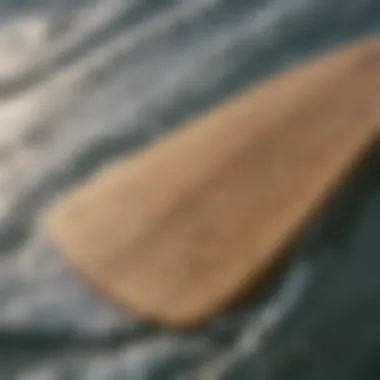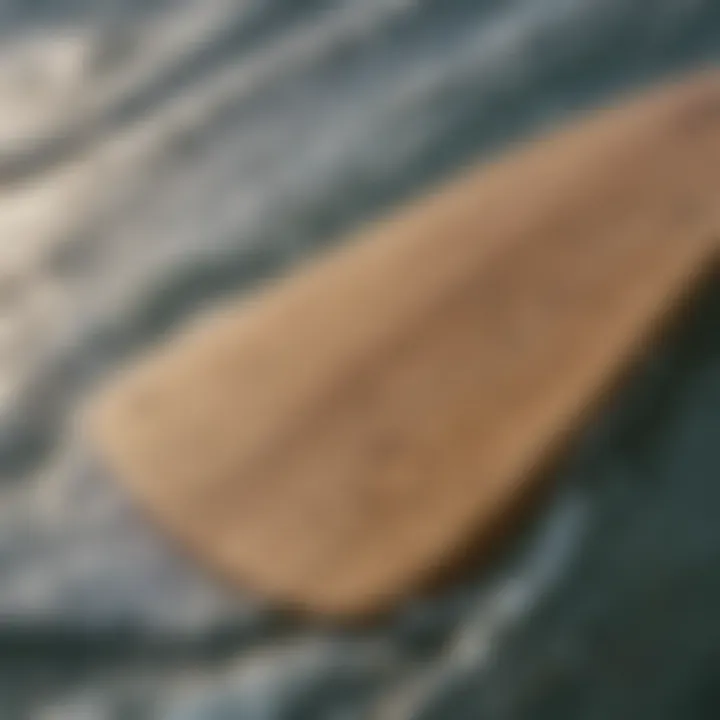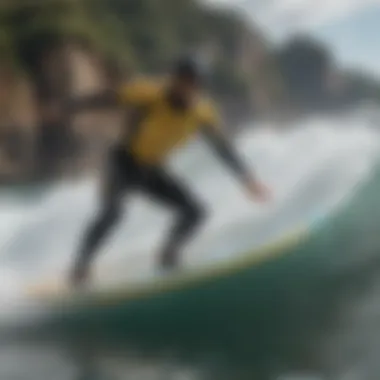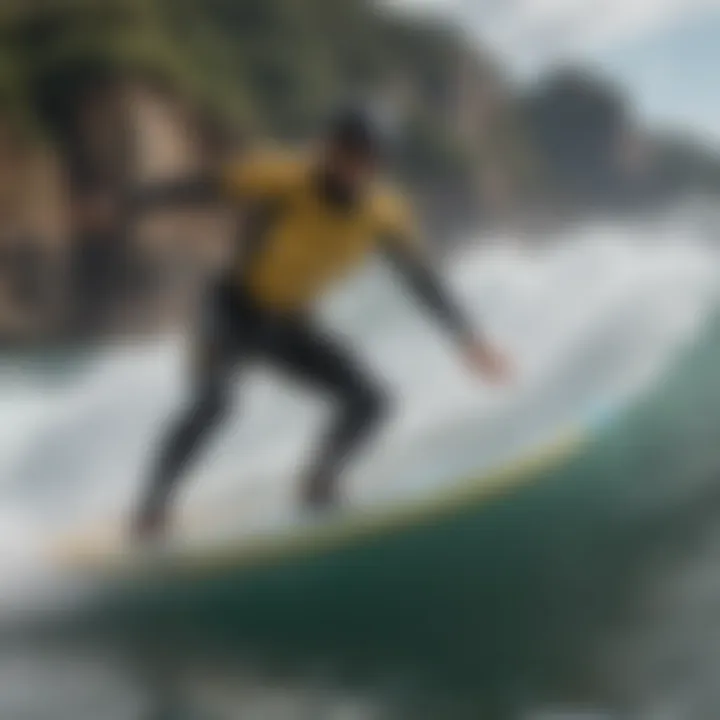Beginner Wake Surf Boards: Essential Insights


Intro
Wake surfing is a rapidly growing sport, combining the excitement of surfing with the thrill of being towed behind a boat. For many newcomers, selecting the right gear is crucial, especially when it comes to choosing a wake surf board. The board can significantly influence performance and enjoyment on the water. Understanding the necessary features of a board, its construction, and how it suits your skill level is essential to maximize fun and safety.
This guide aims to inform beginners about various aspects of wake surf boards. We will discuss the techniques required to advance in this sport, essential gear to consider, and key safety measures. Just as important are insights into common pitfalls to avoid during your wake surfing journey, allowing you to have a smoother experience.
Let’s delve deeper into the techniques and tips that will lay a solid foundation for a successful wake surfing adventure.
Understanding Wake Surfing
Understanding wake surfing is crucial for anyone eager to embark on this exciting water sport. Wake surfing enables riders to navigate the wake generated by a boat while maintaining a safe distance, allowing for a unique surfing experience without the need for waves. In this section, we will delve into the essence of wake surfing, its definition, and cover significant historical elements that have shaped its development.
Defining Wake Surfing
Wake surfing is defined as riding a surfboard without being attached to the boat. Unlike traditional water skiing or wakeboarding, riders use the wake created by the boat to propel themselves. This sport requires balance, timing, and an understanding of body movements. Riders typically start by holding onto the tow rope until they find their balance, at which point they can drop the rope and enjoy the ride.
One of the defining aspects of wake surfing is its emphasis on a relaxed, flowing style. This contrasts with the more aggressive energy found in wakeboarding. Wake surfing allows enthusiasts to connect with nature while enjoying the thrill of gliding over the water. The board's design and features can influence the ride, making it necessary for beginners to understand how different wake surf boards affect performance.
A Brief History of Wake Surfing
Wake surfing has its origins tied to the practices of surfing in natural environments. However, it was during the late 1990s that it began to emerge as a distinct sport. Initially, surfers in California experimented with the idea of creating a wake behind their boats, thus allowing them to surf in lakes and rivers. Early wake surfers used modified surfboards designed for ocean waves, which eventually led to the development of specific boards tailored for the sport.
By the early 2000s, as more people became aware of wake surfing, several manufacturers began producing boards specifically designed for this purpose. Today, there are numerous brands and models, each engineered to deliver unique experiences on the water. The sport has continued to grow, attracting thrill-seekers and adventure lovers seeking new challenges.
Understanding wake surfing's definition and history will empower beginners to appreciate the nuances of this sport. The knowledge equips newcomers with insights on techniques, equipment, and community values, contributing to a more enriching and safer experience on the water.
Importance of Choosing the Right Wake Surf Board
When embarking on your wake surfing journey, selecting the appropriate surf board is crucial. This decision significantly influences your performance and overall experience on the water. The right board not only aligns with your skill level but also adapts to different water conditions and styles of surfing. By understanding its value, beginners can ensure they have a more enjoyable and successful experience.
Impact on Performance and Experience
The performance of wake surfing is intrinsically linked to the characteristics of the surf board. An ill-suited board can make even the simplest maneuvers feel daunting. On the other hand, a well-chosen board can enhance your ability to learn and progress. Beginner surfers often lack the experience to read the waves or utilize the water’s flow efficiently. Therefore, having a board that provides stability and maneuverability is essential.
A wake surf board that matches your weight, height, and skill level can also improve your ability to perform tricks and turns. This adaptability breeds confidence, which is key for any beginner. You will find that as you become accustomed to the dynamics of riding, the right board will naturally complement your movements, helping you maintain balance. In essence, the initial choice sets the foundation for both skill acquisition and enjoyment.
Different Board Shapes and Their Benefits
Not all wake surf boards are created equal. Each shape offers unique benefits that cater to different surfing styles and preferences.
- Fish Shape: These boards are shorter and wider, making them incredibly stable. Fish shapes are great for beginners who need that extra balance as they learn how to stay upright. They glide smoothly yet allow for tighter turns.
- Traditional Shape: With a more extended profile, traditional boards provide excellent speed and control. Their versatility makes them suitable for various water conditions. They are ideal for riders who are slightly more advanced but still new to the sport.
- Hybrid Shape: Combining the features of both fish and traditional shapes, hybrid boards cater to a broad range of surfing styles. They offer maneuverability paired with stability, allowing beginners to experiment with various techniques without feeling overwhelmed.
Understanding these board shapes and their intentional design serves as a guide for new enthusiasts. Choosing the right shape enhances your safety, improves your skills, and ultimately prepares you for more thrilling experiences on the water.
Key Features of Beginner Wake Surf Boards
Selecting the right wake surf board is critical for beginners aiming to enjoy their time on the water. Each feature of the board contributes to the overall performance, comfort, and learning curve. Understanding these features can significantly affect your experience, allowing for smoother transitions and better control. Below we explore key elements that every newcomer should consider.
Volume and Weight Capacity
Volume directly correlates with buoyancy. A board with higher volume can float better, making it easier for beginners to balance and stay on top of the water. This is especially beneficial for those who are not used to surfing or floating on a board. Beginners often struggle with balance, and a board that offers more volume can be less daunting.
Weight capacity is another essential aspect to consider. It is imperative to choose a board that accommodates your weight and provides enough support. A mismatched weight capacity can lead to a lack of control and stability while riding. Boards come with varied capacity, and selecting the right one can make learning feel more effortless and enjoyable.
Construction Materials
The material of a wake surf board influences its performance and durability. Common materials include fiberglass, epoxy, and foam. Fiberglass boards are often more rigid and provide responsive rides, but they can be heavy. Epoxy boards, on the other hand, are lighter and offer better flotation which can be advantageous for beginners who desire ease of use.


Foam boards can also be a good entry point. They are typically softer and safer, reducing the chances of injury during falls, which can commonly happen in the learning phase.
Choosing the right construction material is crucial because it affects not only performance but also how long the board will last. Investing in a well-made board can save money and enhance your overall experience.
Fin Configuration
Fin configuration impacts how the board handles in the water. A board can have different setups like single, twin, or thruster fins. Each setup provides distinct advantages. For beginners, a board with a larger single fin can provide added stability. This will help you to stay oriented in the water without losing your direction easily.
Twin fins might offer a bit more maneuverability than a single fin. However, for those just starting out, the simplicity of a single fin is often better. A thruster setup can be more advanced but can provide responsive turns as skill levels improve.
The fin's size and positioning also characterize the handling of the board. Beginners should consider options that allow for easy adjustments, enabling them to customize the board as their skills develop.
Takeaway: Always weigh your options carefully. The right combinations of volume, materials, and fin setups can make all the difference in achieving a smooth and enjoyable wake surfing experience.
Popular Beginner Wake Surf Boards
Choosing the right wake surf board is crucial for any new enthusiast. This selection impacts the overall experience and enjoyment of the sport. Popular beginner wake surf boards are specifically designed with the novice in mind, offering features that support learning and confidence on the water. Understanding what models are available can help beginners narrow down their choices, ensuring they select a board suited to their needs, both in performance and comfort.
Many factors influence board selection, including size, shape, and construction. A well-chosen board can make a significant difference in helping beginners master essential skills quickly. Therefore, knowing the options and their associated benefits is paramount.
Top Models in the Market
Several wake surf boards stand out for beginners. Here are a few notable models:
- Liquid Force Rocket: This board is known for its generous width, offering stability for new riders. The rocker profile enhances maneuverability, helping novices navigate turns with ease.
- Hyperlite Landlock: Its foam core and forgiving shape make it a suitable choice for learning. The Landlock provides a solid platform to practice getting up and finding balance.
- Ronix Marsh Mellow: This board is designed to be soft in the water. Its unique features offer an excellent blend of buoyancy and control, ideal for those just starting out.
These models feature a combination of stability, performance, and ease of use, all essential for a beginner's success. Each model has been tested by users and gained popularity in the wake surfing community for these reasons.
Brand Recommendations
Some brands consistently produce quality boards that cater to beginners. These include:
- Liquid Force: Renowned for their innovative designs and user-friendly features. They focus on creating boards that support gradual skill development.
- Hyperlite: Another leading brand with a strong reputation. Their boards often include beginner-friendly shapes, making them a favorite among newcomers.
- Ronix: Known for their commitment to quality and performance. They offer a range of boards specifically designed for those new to the sport.
Selecting a board from reputed brand can provide assurances of quality. Each of these brands has invested in research to create boards that enhance the experience for new riders, fostering a successful entry into wake surfing.
"Choosing the right board shapes the learning process, making it vital for any beginner."
In summary, understanding popular beginner wake surf boards and their features can empower newcomers to make informed decisions. By considering the models and brands that prioritize stability and ease of use, enthusiasts can look forward to an enjoyable wake surfing journey.
Understanding Your Skill Level
Understanding your skill level is fundamental in wake surfing, especially for beginners. Your capabilities directly influence the type of board you should select, as well as how effectively you will be able to learn the sport. Recognizing your experience can help you tailor your training regimen. Each wake surfer has a unique progression path based on personal comfort and prior experiences.
Assessing your skill level involves a genuine reflection on your previous experience with water sports or similar activities. If you have minimal experience, it is crucial to start with a board that offers stability, enabling you to establish a solid foundation. Alternatively, those with some prior experience may benefit from a more versatile board that allows for progression and deeper exploration of techniques.
Additionally, understanding your comfort level is essential. The right board should not only match your skills but also make you feel at ease while riding. This comfort influences your performance and enjoyment on the water.
Assessing Your Experience and Comfort
To accurately assess your experience and comfort, consider the following points:
- Previous Water Sports Experience: Engage in self-reflection to determine your history with activities like water skiing or surfing. Those familiar with balance-oriented sports may adapt quicker to wake surfing.
- Physical Fitness: Your overall fitness level can affect your ability to learn and perform maneuvers. Strong core muscles provide better balance and stability on the board.
- Mindset and Confidence: Mental readiness plays a critical role. If you feel excited yet slightly apprehensive, this is a normal response. Engaging with experienced surfers can provide reassurance and enhance your confidence.
Matching Boards to Skill Levels
Selecting the appropriate wake surfboard based on your skill level is crucial for an enjoyable learning experience. Here are some considerations:


- Beginner Boards: These boards are typically wider and thicker, promoting greater stability and balance. They are perfect for newcomers who are just starting to learn the ropes. Models such as the Liquid Force Buzzz are excellent for stability and ease of use.
- Intermediate Boards: If you have some experience, you might opt for boards that are slightly smaller and more responsive. This can help in learning different tricks and maneuvers. Look into boards like the CWB Ride, known for their versatility.
- Advanced Boards: Advanced surfers will require boards that prioritize speed and maneuverability. The differences in construction can enhance performance significantly. If you reach this level, boards like the Slingshot B.A. are designed specifically for high-level performance.
As you evolve in wake surfing, engaging with a community can be beneficial to understand which boards might suit you best. Online forums and local groups often share personal experiences and recommendations. Stay receptive to feedback from skilled surfers, as their insights can guide you to make more informed decisions.
"Choosing the right wake surf board accelerates the learning process, leading to more enjoyable sessions on the water."
By thoughtfully assessing your experience and aligning with suitable board options, you set the stage for success in wake surfing, allowing for a more fulfilling experience.
Basic Techniques for Wake Surfing Success
Mastering basic techniques is crucial for success in wake surfing. These fundamental skills not only enhance your experience but also promote safety on the water. As a beginner, developing your stance and maneuvering abilities will lay a strong foundation for your journey. This section will delve into two essential aspects: stance and balance, and turning and maneuvering. Each of these elements contributes significantly to your performance and enjoyment in wake surfing.
Stance and Balance
A proper stance is the cornerstone of effective wake surfing. The way you position your body on the board dictates your balance, which in turn impacts your control over the board and your ability to ride the wave. First, positioning your feet shoulder-width apart is essential. This width provides a stable base. Your toes should point towards the nose of the board.
Keep your knees slightly bent. This bend allows for better shock absorption from the wave and helps maintain balance. Your core should be engaged, enabling you to respond quickly to shifts in weight or changes in the water conditions.
Here are a few tips to improve your stance and balance:
- Practice on land: Before stepping onto the board, practice your stance on dry ground. This exercise helps you understand the balance points.
- Find your center of gravity: Experiment with shifting your weight forward and backward while in position. Finding this sweet spot will immensely improve your stability.
- Stay relaxed: Tension can lead to stiffness, which negatively affects balance. Try to stay loose and fluid.
"A strong stance creates the groundwork for quick adjustments, making your ride smoother and more enjoyable."
With a solid stance, you can confidently move on to the next key technique.
Turning and Maneuvering
Once you have established a good stance, the next skill to master is turning and maneuvering your board. This technique allows you to navigate the wave effectively and explore different riding styles. Before tackling more complex moves, start with basic turns.
To initiate a turn, lean your body in the direction you want to go. For example, if turning left, shift your weight onto your left foot while gently pulling your right foot back. This motion shifts the board’s edge into the water, allowing for a smooth turn.
A few important considerations include:
- Look where you want to go: Your body will naturally follow your gaze, so looking in the direction of your desired turn will help guide your movements.
- Use your hips: Engage your hips to create more impactful turns. Rotating your hips toward the direction of the turn enhances weight distribution and responsiveness.
- Practice small turns: Begin with slight adjustments before attempting wider turns. Small movements will help you gain confidence and control.
As you improve, consider incorporating more advanced maneuvers, such as carving. Combining these techniques will allow you to navigate waves with precision and style while fulfilling the fundamental objectives of fun and safety in wake surfing.
Safety Considerations in Wake Surfing
Safety is an essential aspect of wake surfing that often cannot be overstated. As enjoyable as the sport can be, the risks are present, particularly for beginners. Understanding safety considerations can make a considerable difference in one’s experience on the water. Prioritizing safety not only protects oneself but also ensures the well-being of others nearby.
Gear and Equipment Safety
When venturing into wake surfing, having the right gear is fundamental. Essential items include a properly fitted life jacket, which must comply with safety regulations. It is vital that the life jacket allows freedom of movement while providing enough buoyancy in case of a fall. Beginners should also consider using a helmet, especially if they lack experience. This can provide an added layer of protection against potential falls or collisions.
Maintaining equipment is another critical component. Inspecting the wake surf board for any damages, particularly in the fins or surface, should be done regularly. A damaged board can result in poor performance or even accidents. Checking the tow rope for fraying and ensuring all mechanisms are functioning correctly contributes to overall safety.
Recognizing and Obeying Water Conditions
Understanding water conditions is essential for practicing wake surfing safely. This includes being aware of the weather patterns, water currents, and any potential hazards in the area. Beginners should refrain from surfing in strong winds or choppy waters, as these conditions can lead to accidents or injuries.
Before starting, it is advisable to assess the following elements:
- Wind Speed: High winds can create unpredictable water conditions, making it tougher to maintain balance.
- Traffic on Water: Being aware of boats, swimmers, and other surfers is very important. This allows for avoiding collisions and ensures that everyone stays safe.
- Underwater Hazards: Items such as rocks or debris can pose severe risks. Researching the area or speaking to local surfers often provides valuable insights into potential hazards.
"Your safety is directly linked to your awareness and preparation. Always prioritize understanding the conditions around you before hitting the water."


By keeping these considerations in mind, beginners can significantly improve their safety when wake surfing. It is important that they focus not only on their enjoyment of the sport but also on being responsible and mindful in every surfing session.
Maintaining Your Wake Surf Board
Caring for your wake surf board is crucial for enhancing its longevity and performance. Maintenance goes beyond simple cleaning; it ensures that your board remains safe and functional for your surfing adventures. A well-maintained board not only performs better but also provides a more enjoyable experience on the water. Additionally, taking proper care of your equipment helps prevent costly repairs or replacements down the line.
Care and Cleaning Guidelines
Keeping your wake surf board clean is vital for preserving its condition. After each surfing session, rinse the board with fresh water. This prevents saltwater or chlorinated water from degrading the materials over time. When cleaning, avoid using harsh chemicals that can damage the board's surface. A mild soap and soft cloth should suffice.
Tips for cleaning:
- Always rinse your board after use, especially after being in saltwater.
- Use a specific surfboard cleaner or a mild detergent for deeper cleans.
- Store the board in a cool, dry place away from direct sunlight to avoid warping or fading.
"Regular maintenance will extend your board's lifespan and enhance your wake surfing experience."
When to Replace Components
Over time, certain components of your wake surf board may require replacement. This includes fins, pads, and even the board itself, depending on wear and tear. Inspect these elements regularly for any damage or signs of deterioration. If fins are chipped or the traction pad is peeling, consider replacing them promptly to maintain performance.
Indicators that replacement is needed:
- Visible cracks or chips in the fin or board.
- Reduced grip from the traction pad.
- Any signs of water entering the board due to cracks.
Monitoring the condition of your wake surf board ensures safety and improves your overall experience in the water. By keeping both the surface and components in top shape, you can focus on enhancing your skills and enjoying the ride.
Community and Resources for Beginners
When venturing into the realm of wake surfing, connecting with a community and utilizing available resources is vital for beginners. Engaging with fellow enthusiasts not only enhances your knowledge but also enriches the overall experience. Beginners often find themselves facing a steep learning curve, and having support can provide both motivation and reassurance.
Finding Local Wake Surfing Groups
Identifying local wake surfing groups offers numerous advantages. These groups provide a platform for sharing experiences, tips, and techniques. Participants can learn from each other's successes and challenges. Many towns near water bodies will have clubs or informal gatherings. It is possible to find these groups through social media platforms like Facebook, which often have dedicated pages for wake surfing enthusiasts.
Local meetups can also foster new friendships and partnerships, making it easier to find someone to share a boat and learn alongside.
- Network with locals: Attend events or look for announcements at local marinas.
- Community: Build valuable friendships with people who share the same passion.
- Knowledge sharing: Gain insights from others who are more advanced.
Online Forums and Learning Platforms
The digital space hosts a plethora of resources geared towards wake surfing beginners. Online forums such as Reddit have communities where users can post questions, share tips, and discuss everything related to wake surfing. Engaging in these platforms allows for a broader knowledge base, where experiences from surfers around the globe can inform and guide you.
Learning platforms often feature instructional videos and tutorials that cater specifically to beginners. Websites like YouTube can be invaluable for visual learners. A detailed search for specific topics can yield great results. Online courses may also exist, offering structured lessons aimed at foundational techniques and safety practices.
In summary, leveraging both local groups and online resources can significantly enhance a beginner’s journey in wake surfing. This approach not only builds skills and confidence but also creates a connected community of like-minded individuals, ensuring a richer and more supported experience.
Closure
In the context of this article, the conclusion serves to encapsulate the essential insights gathered throughout the discussion on beginner wake surf boards. This segment is crucial as it reinforces the importance of selecting a suitable board while emphasizing the safety protocols and skill development necessary for a fulfilling wake surfing experience.
Beginner surfers should understand that the right board can significantly enhance their performance on the water. A board that aligns with one's skill level can foster confidence, encourage practice, and lead to faster progression in techniques. Moreover, acknowledging the role of safety cannot be understated. Proper equipment and awareness of environmental conditions protect both the individual and others in the vicinity.
Summarizing the key points of board selection, safety, and resources available can empower new enthusiasts to take informed steps toward their wake surfing journey. This reflective moment in the article cements the foundational considerations for beginners. By distilling these insights, it enables newcomers to transition into skilled surfers with greater ease and enjoyment.
Summarizing Key Points
- Importance of Board Selection: Choosing the right wake surf board tailored to individual skill and comfort will enhance overall performance.
- Focus on Safety: Emphasizing safety in gear and environmental awareness is paramount for enjoyable and secure experiences.
- Skill Development and Resources: Engaging with local communities and online platforms fosters growth and learning in wake surfing.
- General Care of Equipment: Understanding basic maintenance and care for wake surf boards ensures longevity and optimal performance.
Encouragement for Beginners
As you begin your wake surfing journey, it is essential to keep an open mind and be patient with yourself. Every expert was once a beginner, and improvement comes with time and practice. Do not hesitate to seek guidance from experienced surfers or local communities. They can provide valuable tips and insights based on their experiences.
Remember that safety comes first. Embrace the learning curve and take every opportunity to practice your skills in a controlled environment. Focus on building your confidence gradually. With dedication, you can look forward to the thrill and joy that comes with riding the wake.
Stay curious, ask questions, and most importantly, enjoy the ride!







